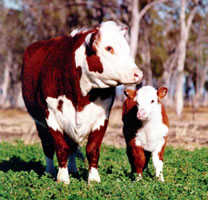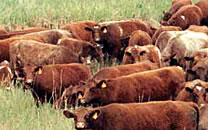Industry Development
The Development of the Beef Industry in Australia
Beef cattle came to Australia with the first European settlers in 1788 and were used for supplying beef and milk to the new colony. The industry spread with new settlement through most of the next 100 years, though still supplying the beef needs of only the local communities. The real backbone of Australian agriculture through the 19th century was wool, and for many years beef was seen as a poor cousin. The breakthrough that started the genuine development of the beef industry was the first shipment of frozen beef from Australia to the UK. This was Australia’s first exposure to international markets and led to the significant expansion of cattle into northern Australia.
Early development of the Australian beef cattle industry was based on the Shorthorn breed, due to its adaptability to Australian conditions. The hot, dry and rugged pastoral regions of north-western Queensland, the Northern Territory and the Kimberley region of Western Australia could be economically grazed by the Shorthorn, and it quickly became the major breed.
The Hereford breed also expanded rapidly, quickly becoming the dominant breed throughout southern Australia. The expansion of this breed was due in a large part to the opening of the UK market. With the continued development of the beef industry through the 1900s, the Hereford breed gradually established its dominance in the Australian herd.
The Angus breed developed mainly in south-eastern regions of the continent, where it thrived on the lush pasture produced by high rainfall. The breed has expanded rapidly in the past two decades due to the growth of lot feeding in Australia. With its good meat marbling and tenderness qualities coupled with its ability to be managed in a lot feeding environment, the Angus successfully meets the needs of the specialised Japanese export market. The Red Angus has also increased in popularity in recent years, particularly in northern Australia where its red colour gives a comparative heat tolerance advantage.
Other British breeds introduced to the south-eastern high rainfall areas of Australia by the early European settlers were the Devon, South Devon, Galloway, Red Poll, Lincoln Red and British White, although these have not expanded as successfully as the Angus.

The opening of the US market for Australian grinding beef in 1960 spurred industry expansion, particularly in northern Australia. At around the same time, industry innovators were starting to notice the adaptability of Bos indicus cattle to northern Australia. Of particular relevance was their genetic resistance to ticks and their heat and humid climate tolerance.
While resistance to the introduction of Brahman cattle was initially strong, their value traits could not be ignored and Bos indicus cattle now dominate the pastoral regions of northern Australia.
Early importation of Bos indicus cattle, then known as Zebu types, came from India. But the development of tropical cattle production only really began with the introduction of the American Brahman breed in 1933, predominantly to the tropical coastal areas of Queensland. In order to maximise productivity while also achieving heat and tick tolerance, Bos taurus cattle were crossed with Bos indicus cattle. Composite breeds include the Droughtmaster, Braford, Brangus, Belmont Red, Charbray and Simbrah.
The genetic base of breeds suitable for beef production in the hot, harsh, tropical areas of Australia was also widened by the importation of other tropical beef breeds. Santa Gertrudis from America, the Africander, Tuli and Boran from southern Africa, and the Sahiwal and Red Sindhi from the Indian sub-continent all contributed favourable characteristics to the genetic pool.
In the late 1970s, the federal government, in conjunction with the beef industry, launched the Brucellosis and Tuberculosis Eradication Scheme (BTEC). Although ultimately successful, and of immense benefit to the Australian beef industry, it caused major disruption to cattle producers in northern Australia. The BTEC program has, however, greatly improved the management of northern Australian cattle with accompanying gains in beef quality. As a result the northern Australian cattle industry was well positioned to take advantage of the live cattle trade to South East Asia, which subsequently emerged in the 1990s.
Cattle production in Australia can now be roughly divided geographically between the Bos indicus and Bos taurus areas. An imaginary line running west from the city of Brisbane divides cattle production into north and south. North of the line, production is based on Bos indicus genetics while production south of this line is based on Bos taurus genetics, although overlapping does occur.
Southern beef production has seen the development of composite breeds based on British and/or European stock. The best known of these is the Murray Grey, which was developed from grading up Shorthorn and Angus foundation stock to the point that now it has become a major southern breed. The Murray Grey has developed an excellent reputation for its carcase quality, which is suited to the Japanese grain fed market. Other composite breeds include the Mandalong Special and Chiangus, while small framed breeds such as the Angus derived Lowline, the Murray Grey derived Square Meater and the Mini Hereford enjoy some niche popularity.
The major European breeds were not introduced into Australia until the early 1970s. These breeds were initially introduced via semen imports, followed by imports of part-bred and purebred animals as well as fertilised ova. The breeds included the Charolais, Simmental, Limousin and Chianina. Other breeds to follow were the Maine-Anjou, Romagnola, Blonde D’Aquitaine, Brown Swiss and Marchigiana. Their popularity was based primarily on cattlemen seeking to increase the frame size of their cattle and to decrease fat cover. Salers, Gelbvieh, Piedmontese, Braunvieh, Belgian Blue, Bazadaise and the Japanese Wagyu have also been imported. Some of these breeds are attracting significant interest from producers and buyers while others have failed to expand.
